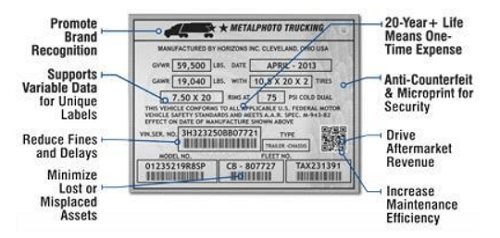Overweight or overloaded trailers are a big problem on roads worldwide. Vehicles hauling too-heavy or improperly-loaded trailers are at a greater risk for loss of control down inclines, delayed braking issues, and tipping due to uneven weight. Fortunately, there exist strict mandates in the United States, (thanks to the guidelines laid out by the FMCSA) that are designed to help guarantee that weight will never be an issue.
One of the ways in which this is possible is GVWR and GAWR. Though these acronyms sound similar and both concern weight safety, they are uniquely different. Let’s see why.

GVWR, short for gross vehicle weight rating, is a unit that is used for a wide range of vehicles, starting from lightweight pick-up trucks, moving all the way up to the heaviest-duty tractor trailers allowed on roadways.
While GVWR is attributed to different classifications of vehicles (i.e., trucks vs. trailers), its main message is the same. In a nutshell, it gives two very vital pieces of information:
plus
2. the weight of all optional truck and/or trailer accessories (anything that does not come standard from the manufacturer).
The second facet of GVWR is an important one as these optional accessories can add on plenty of extra weight to the total load. It should also be noted that GVWR includes the weight of the operator, as well as any passengers.
There is a formula for calculating GVWR, which is useful once things like optional accessories and passengers come into play. It is as follows:
GVWR= Trailer Capacity + Trailer Weight
Broken down, trailer capacity is the maximum amount of weight that the trailer can hold, and the trailer weight is the combined weight of every item that is being hauled in the trailer.
Like various other trailer weight factors, the GVWR is likely to never change. The only reason this might occur is if a manufacturer issues a recall, or if there is a formal change made by an issuing authority, such as the U.S. Department of Transportation (DOT).
GAWR, short for gross axle weight rating, is a unit that is applied to all kinds of vehicles, but specifically vehicles that have multiple axles, starting with a car, and moving all the way up to multi-axle trailers.
GAWR is a unit stipulated by the manufacturer of the trailer and/or vehicle that states the maximum amount of weight that can be placed on each of the axles. You can expect a gross axle weight rating to differ between front and rear axles, as different ends of the vehicle can handle different amounts of weight.
Similar to GVWR, the GAWR of a trailer will always remain the same unless the manufacturer issues a recall or an authority like DOT changes its guidelines.
If you are unsure of where to locate a trailer’s GAWR, check inside a door frame, where you will see the manufacturer’s placard. There, you will also find other pertinent weight information, like GVWR.

The key differences between GVWR and GAWR mostly concern the way in which weight capacity is handled.
For instance, GVWR is used as a way to look at the trailer’s weight, as is and with only standard equipment. By removing all other variables, even the weight of passengers or a load, we get an idea of the trailer’s constraints. Added to that is the additional weight of all items and/or people that have been brought on.

On the other hand, we have GAWR, which is used to measure the maximum amount of weight on each axle. As mentioned, the GAWR will vary on the same trailer depending upon the placement and/or the number of axles. GAWR is not to be confused with GAW, the gross axle weight, a number that is constantly changing based on how much weight is added and taken away from the trailer. The GAW must always be lower than or equal to the GAWR, so it’s important to have the vehicle’s GAWR displayed with other data on the vehicle’s data plate. To aid compliance, choose data plates constructed of a durable material such as Metalphoto® to ensure that the GAWR, GVWR, and other important data remains legible throughout the vehicle’s lifespan.
While both GVWR and GAWR are used to measure weight on trailers and other vehicles, they are unique in what they measure. GVWR can be considered more as a big-picture unit system that is designed to look at a trailer’s weight overall. Conversely, GAWR only concerns the maximum weight as it relates to the trailer’s axles, and nothing else.
Both GVWR and GAWR are incredibly important, unchanging numbers that every operator and fleet manager should know. To get a more in-depth look at GVWR and GAWR, as well as the guidelines that are attached to them, consult FMCSA’s manual.
Our sales engineers are experts in automatic asset tracking, tagging and identification,a nd can answer all your questions. Get in touch now.
Lets Talk ›